Abalone
Abalone (/ˈæbəloʊniː/ (![]()
| Abalone | |
|---|---|
| Living abalone in tank showing epipodium and tentacles, anterior end to the right. | |
| Scientific classification | |
| Kingdom: | |
| Phylum: | |
| Class: | |
| Subclass: | |
| Superfamily: | |
| Family: | Rafinesque, 1815 |
| Genus: | |
| Type species | |
| Haliotis asinina Linnaeus, 1758 Linnaeus, 1758 | |
| Species | |
|
57, see species section. | |
| Synonyms[4] | |
| |
Other common names are ear shells, sea ears, and muttonfish or muttonshells in Australia, ormer in the UK, perlemoen in South Africa, and paua in New Zealand.[5]
Abalone are marine snails. Their taxonomy puts them in the family Haliotidae, which contains only one genus, Haliotis, which once contained six subgenera. These subgenera have become alternate representations of Haliotis.[4] The number of species recognized worldwide ranges between 30[6] and 130[7] with over 230 species-level taxa described. The most comprehensive treatment of the family considers 56 species valid, with 18 additional subspecies.[8]
The shells of abalones have a low, open spiral structure, and are characterized by several open respiratory pores in a row near the shell's outer edge. The thick inner layer of the shell is composed of nacre (mother-of-pearl), which in many species is highly iridescent, giving rise to a range of strong, changeable colors, which make the shells attractive to humans as decorative objects, jewelry, and as a source of colorful mother-of-pearl.
The flesh of abalones is widely considered to be a desirable food, and is consumed raw or cooked by a variety of cultures.
Description
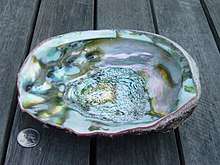
Abalone vary in size from 20 mm (0.79 in) (Haliotis pulcherrima) to 200 mm (7.9 in) while Haliotis rufescens is the largest of the genus at 12 in (30 cm).[9]
The shell of abalones is convex, rounded to oval in shape, and may be highly arched or very flattened. The shell of the majority of species has a small, flat spire and two to three whorls. The last whorl, known as the body whorl, is auriform, meaning that the shell resembles an ear, giving rise to the common name "ear shell". Haliotis asinina has a somewhat different shape, as it is more elongated and distended. The shell of Haliotis cracherodii cracherodii is also unusual as it has an ovate form, is imperforate, shows an exserted spire, and has prickly ribs.
A mantle cleft in the shell impresses a groove in the shell, in which are the row of holes characteristic of the genus. These holes are respiratory apertures for venting water from the gills and for releasing sperm and eggs into the water column. They make up what is known as the selenizone, which forms as the shell grows. This series of eight to 38 holes is near the anterior margin. Only a small number is generally open. The older holes are gradually sealed up as the shell grows and new holes form. Each species has a typical number of open holes, between four and 10, in the selenizone. An abalone has no operculum. The aperture of the shell is very wide and nacreous.
The exterior of the shell is striated and dull. The color of the shell is very variable from species to species, which may reflect the animal's diet.[5] The iridescent nacre that lines the inside of the shell varies in color from silvery white, to pink, red and green-red to deep blue, green to purple.
The animal has fimbriated head lobes and side lobes that are fimbriated and cirrated. The radula has small median teeth, and the lateral teeth are single and beam-like. They have about 70 uncini, with denticulated hooks, the first four very large. The rounded foot is very large in comparison to most molluscs. The soft body is coiled around the columellar muscle, and its insertion, instead of being on the columella, is on the middle of the inner wall of the shell. The gills are symmetrical and both well developed.[10]
These snails cling solidly with their broad, muscular foot to rocky surfaces at sublittoral depths, although some species such as Haliotis cracherodii used to be common in the intertidal zone. Abalones reach maturity at a relatively small size. Their fecundity is high and increases with their size, laying from 10,000 to 11 million eggs at a time. The spermatozoa are filiform and pointed at one end, and the anterior end is a rounded head.[11]
The adults provide no further assistance to the larvae and they are described as lecithotrophic. The adults are herbivorous and feed with their rhipidoglossan radula on macroalgae, preferring red or brown algae.
Distribution
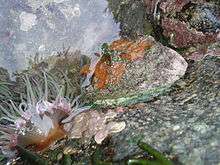
The haliotid family has a worldwide distribution, along the coastal waters of every continent, except the Pacific coast of South America, the Atlantic coast of North America, the Arctic, and Antarctica.[12] The majority of abalone species are found in cold waters, such as off the coasts of New Zealand, South Africa, Australia, Western North America, and Japan.[13]
Structure and properties of the shell
The shell of the abalone is exceptionally strong and is made of microscopic calcium carbonate tiles stacked like bricks. Between the layers of tiles is a clingy protein substance. When the abalone shell is struck, the tiles slide instead of shattering and the protein stretches to absorb the energy of the blow. Material scientists around the world are studying this tiled structure for insight into stronger ceramic products such as body armor.[14] The dust created by grinding and cutting abalone shell is dangerous; appropriate safeguards must be taken to protect people from inhaling these particles.[15]
Diseases and pests
Abalones are subject to various diseases. The Victorian Department of Primary Industries said in 2007 that ganglioneuritis killed up to 90% of stock in affected regions. Abalone are also severe hemophiliacs as their fluids will not clot in the case of a laceration or puncture wound. Members of the Spionidae of the polychaetes are known as pests of abalone.[16]
Human use
The meat (foot muscle) of abalone is used for food, and the shells of abalone are used as decorative items and as a source of mother of pearl for jewelry, buttons, buckles, and inlay.[17] Abalone shells have been found in archaeological sites around the world, ranging from 100,000-year-old deposits at Blombos Cave in South Africa to historic Chinese abalone middens on California's Northern Channel Islands.[18][19] On the Channel Islands, where abalones were harvested by Native Americans for at least 12,000 years, the size of red abalone shells found in middens declines significantly after about 4000 years ago, probably due to human predation. Worldwide, abalone pearls have also been collected for centuries.
Farming
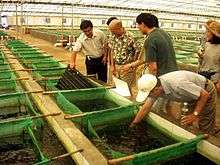
Farming of abalone began in the late 1950s and early 1960s in Japan and China.[20] Since the mid-1990s, there have been many increasingly successful endeavors to commercially farm abalone for the purpose of consumption.[21] Overfishing and poaching have reduced wild populations to such an extent that farmed abalone now supplies most of the abalone meat consumed. The principal abalone farming regions are China, Taiwan,[22] Japan, and Korea. Abalone is also farmed in Australia, Canada, Chile, France,[23] Iceland, Ireland, Mexico, Namibia, New Zealand, South Africa, Spain,[24] Thailand, and the United States.[25]
After trials in 2012,[26] a commercial "sea ranch" was set up in Flinders Bay, Western Australia to raise abalone. The ranch is based on an artificial reef made up of 5000 (As of April 2016) separate concrete units called abitats (abalone habitats). The 900-kilogram (2,000 lb) habitats can host 400 abalone each. The reef is seeded with young abalone from an onshore hatchery.
The abalone feed on seaweed that has grown naturally on the habitats; with the ecosystem enrichment of the bay also resulting in growing numbers of dhufish, pink snapper, wrasse, Samson fish among other species.
Brad Adams, from the company, has emphasised the similarity to wild abalone and the difference from shore-based aquaculture. "We're not aquaculture, we're ranching, because once they're in the water they look after themselves."[27][28]
Consumption
Abalones have long been a valuable food source for humans in every area of the world where a species is abundant. The meat of this mollusc is considered a delicacy in certain parts of Latin America (particularly Chile), France, New Zealand, East Asia and Southeast Asia. In the Greater China region and among Overseas Chinese communities, abalone is commonly known as bao yu, and sometimes forms part of a Chinese banquet. In the same way as shark fin soup or bird's nest soup, abalone is considered a luxury item, and is traditionally reserved for special occasions such as weddings and other celebrations. However, the availability of commercially farmed abalone has allowed more common consumption of this once rare delicacy.
Abalone started to become popular after the Panama–Pacific International Exposition in 1915.[29]
As abalone became more popular and less common, the prices adjusted accordingly. In the 1920s, a restaurant-served portion of abalone, about 4 ounces, would cost (in inflation adjusted dollars) about $7; by 2004, the price had risen to $75.[29] In America, prior to this time, abalone was predominantly eaten, gathered, and prepared by Chinese immigrants.[30] Before that, abalone were collected to be eaten, and used for other purposes by Native American tribes.[31] By 1900, laws were passed in California to outlaw the taking of abalone above the intertidal zone. This forced the Chinese out of the market and the Japanese perfected diving, with or without gear, to enter the market. By the time of the exposition, Americans were starting to discover abalone. The popularity of abalone, along with many other fish and shellfish, increased as the exposition exhibited 365 varieties of fish with cooking demonstrations, and a 1300-seat dining hall.[32]
In Japan, live and raw abalones are used in awabi sushi, or served steamed, salted, boiled, chopped, or simmered in soy sauce. Salted, fermented abalone entrails are the main component of tottsuru, a local dish from Honshū. Tottsuru is mainly enjoyed with sake.[33]
In California, abalone meat can be found on pizza, sautéed with caramelized mango, or in steak form dusted with cracker meal and flour.[34]
Sport harvesting
Australia
Tasmania supplies about 25% of the yearly world abalone harvest.[35] Around 12,500 Tasmanians recreationally fish for blacklip and greenlip abalone. For blacklip abalone, the size limit varies between 138 mm (5.4 in) for the southern end of the state and 127 mm (5.0 in) for the northern end of the state.[36] Greenlip abalones have a minimum size of 145 mm (5.7 in), except for an area around Perkins Bay in the north of the state where the minimum size is 132 millimetres (5.2 in). With a recreational abalone licence, the bag limit is 10 per day, with a total possession limit of 20. Scuba diving for abalone is allowed, and has a rich history in Australia. (Scuba diving for abalone in the states of New South Wales and Western Australia is illegal; a free-diving catch limit of two is allowed).[37][38]
Victoria has had an active abalone fishery since the late 1950s. The state is sectioned into three fishing zones, Eastern, Central and Western, with each fisher required a zone-allocated licence. Harvesting is performed by divers using surface-supplied air "hookah" systems operating from runabout-style, outboard-powered boats. While the diver seeks out colonies of abalone amongst the reef beds, the deckhand operates the boat, known as working "live" and stays above where the diver is working. Bags of abalone pried from the rocks are brought to the surface by the diver or by way of "shot line", where the deckhand drops a weighted rope for the catch bag to be connected then retrieved. Divers measure each abalone before removing from the reef and the deckhand remeasures each abalone and removes excess weed growth from the shell. Since 2002, the Victorian industry has seen a significant decline in catches, with the total allowable catch reduced from 1440 to 787 tonnes for the 2011/12 fishing year, due to dwindling stocks and most notably the abalone virus ganglioneuritis, which is fast-spreading and lethal to abalone stocks.
United States
.jpg)

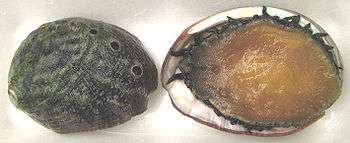
Sport harvesting of red abalone is permitted with a California fishing license and an abalone stamp card. In 2008, the abalone card also came with a set of 24 tags. This was reduced to 18 abalone per year in 2014, and as of 2017 the limit has been reduced to 12, only nine of which may be taken south of Mendocino County. Legal-size abalone must be tagged immediately.[39] Abalone may only be taken using breath-hold techniques or shorepicking; scuba diving for abalone is strictly prohibited.[40] Taking of abalone is not permitted south of the mouth of the San Francisco Bay.[41] A size minimum of 7 in (180 mm) measured across the shell is in place. A person may be in possession of only three abalone at any given time.[42][43]
As of 2017, Abalone season is May to October, excluding July. Transportation of abalone may only legally occur while the abalone is still attached in the shell. Sale of sport-obtained abalone is illegal, including the shell. Only red abalone may be taken, as black, white, pink, flat, green, and pinto abalone are protected by law.[42] In 2018, The California Fish and Game Commission closed recreational abalone season due to dramatically declining populations. That year, they extended the moratorium to last through April, 2021.[44]
An abalone diver is normally equipped with a thick wetsuit, including a hood, bootees, and gloves, and usually also a mask, snorkel, weight belt, abalone iron, and abalone gauge. Alternatively, the rock picker can feel underneath rocks at low tides for abalone. Abalone are mostly taken in depths from a few inches up to 10 m (33 ft); less common are freedivers who can work deeper than 10 m (33 ft). Abalone are normally found on rocks near food sources such as kelp. An abalone iron is used to pry the abalone from the rock before it has time to fully clamp down. Divers dive from boats, kayaks, tube floats, or directly off the shore.[40]
The largest abalone recorded in California is 12.34 in (31.3 cm), caught by John Pepper somewhere off the coast of San Mateo County in September 1993.[45]
The mollusc Concholepas concholepas is often sold in the United States under the name "Chilean abalone", though it is not an abalone, but a muricid.
New Zealand
In New Zealand, abalone is called paua (/ˈpaʊə/, from the Māori language). Haliotis iris (or blackfoot paua) is the ubiquitous New Zealand paua, the highly polished nacre of which is extremely popular as souvenirs with its striking blue, green, and purple iridescence. Haliotis australis and Haliotis virginea are also found in New Zealand waters, but are less popular than H. iris.
Like all New Zealand shellfish, recreational harvesting of paua does not require a permit provided catch limits, size restrictions, and seasonal and local restrictions set by the Ministry for Primary Industries (MPI) are followed. The legal recreational daily limit is 10 per diver, with a minimum shell length of 125 mm (4.9 in) for H. iris and 80 mm (3.1 in) for H. australis. In addition, no person may be in possession, even on land, of more than 20 paua or more than 2.5 kg (5.5 lb) of paua meat at any one time. Paua can only be caught by free-diving; it is illegal to catch them using scuba gear.
An extensive global black market exists in collecting and exporting abalone meat. This can be a particularly awkward problem where the right to harvest paua can be granted legally under Māori customary rights. When such permits to harvest are abused, it is frequently difficult to police. The limit is strictly enforced by roving Ministry for Primary Industries fishery officers with the backing of the New Zealand Police. Poaching is a major industry in New Zealand with many thousands being taken illegally, often undersized. Convictions have resulted in seizure of diving gear, boats, and motor vehicles and fines and in rare cases, imprisonment.
South Africa
The largest abalone in South Africa, Haliotis midae, occurs along roughly two-thirds of the country's coastline. Abalone-diving has been a recreational activity for many years, but stocks are currently being threatened by illegal commercial harvesting.[46] In South Africa, all persons harvesting this shellfish need permits that are issued annually, and no abalone may be harvested using scuba gear.
For the last few years, however, no permits have been issued for collecting abalone, but commercial harvesting still continues as does illegal collection by syndicates.[47] In 2007, because of widespread poaching of abalone, the South African government listed abalone as an endangered species according to the CITES section III appendix, which requests member governments to monitor the trade in this species. This listing was removed from CITES in June 2010 by the South African government and South African abalone is no longer subject to CITES trade controls. Export permits are still required, however. The abalone meat from South Africa is prohibited for sale in the country to help reduce poaching; however, much of the illegally harvested meat is sold in Asian countries. As of early 2008, the wholesale price for abalone meat was approximately US$40.00 per kilogram. There is an active trade in the shells, which sell for more than US$1,400 per metric tonne.
Channel Islands, Brittany and Normandy
Ormers (Haliotis tuberculata) are considered a delicacy in the British Channel Islands as well as in adjacent areas of France, and are pursued with great alacrity by the locals. This, and a recent lethal bacterial disease,[48] has led to a dramatic depletion in numbers since the latter half of the 19th century, and "ormering" is now strictly regulated in order to preserve stocks. The gathering of ormers is now restricted to a number of 'ormering tides', from January 1 to April 30, which occur on the full or new moon and two days following. No ormers may be taken from the beach that are under 80 millimetres (3.1 in) in shell length. Gatherers are not allowed to wear wetsuits or even put their heads underwater. Any breach of these laws is a criminal offence and can lead to fine of up to £5,000 or six months in prison.[49] The demand for ormers is such that they led to the world's first underwater arrest, when Mr. Kempthorne-Leigh of Guernsey was arrested by a police officer in full diving gear when illegally diving for ormers.[50]
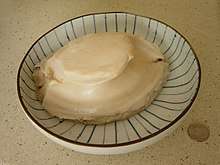 The raw meat of abalone
The raw meat of abalone Abalone sashimi
Abalone sashimi Braised abalones
Braised abalones.jpg) Abalones with asparagus
Abalones with asparagus Abalone bao yu
Abalone bao yu Grilled abalones
Grilled abalones A Korean abalone stew
A Korean abalone stew Abalone Hoe
Abalone Hoe- Abalone with mandarin orange peels.
Decorative items
The highly iridescent inner nacre layer of the shell of abalone has traditionally been used as a decorative item, in jewelry,[5] buttons, and as inlay in furniture and in musical instruments such as on fret boards and binding of guitars, etc.[51]
Abalone pearl jewelry is very popular in New Zealand and Australia, in no minor part due to the marketing and farming efforts of pearl companies. Unlike the Oriental Natural, the Akoya pearl, and the South Sea and Tahitian cultured pearls, abalone pearls are not primarily judged by their roundness. The inner shell of the abalone is an iridescent swirl of intense colours, ranging from deep cobalt blue and peacock green to purples, creams and pinks. Therefore, each pearl, natural or cultured, will have its own unique collage of colours.
The shells of abalone are occasionally used in New Age smudging ceremonies to catch falling ash. They have also been used as incense burners.
Native use
Abalone has been an important staple in native cultures around the world, specifically in Africa and on the North American West coast. The meat was used as food, and the shell was used as currency for many tribes.[52]
Threat of extinction
Abalones have been identified as one of the many classes of organism threatened with extinction due to overfishing and the acidification of oceans from anthropogenic carbon dioxide,[53] as reduced pH erodes their shells. It is predicted that abalones will become extinct in the wild within 200 years at current rates of carbon dioxide production.[54] Currently the white, pink, and green abalone are on the federal endangered species list, and possible restoration sites have been proposed for the San Clemente Island and Santa Barbara Island areas.[55] The possibility of farming abalone to be reintroduced into the wild has also been proposed, with these abalone having special tags to help track the population.[56]
Species
The number of species that are recognized within the genus Haliotis has fluctuated over time, and depends on the source that is consulted. The number of recognized species range from 30[6] to 130.[7] This list finds a compromise using the "WoRMS database", plus some species that have been added, for a total of 57.[4][57] The majority of abalone have not been rated for conservation status. Those that have been reviewed tend to show that the abalone in general is an animal that is declining in numbers, and will need protection throughout the globe.
_S01.jpg) A dorsal view of a live ass's ear abalone, Haliotis asinina
A dorsal view of a live ass's ear abalone, Haliotis asinina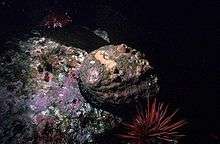 The pink abalone, Haliotis corrugata
The pink abalone, Haliotis corrugata- The black abalone, Haliotis cracherodii
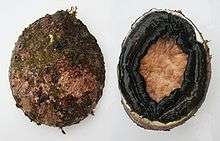 Dorsal (left) and ventral (right) views of the blacklip abalone, Haliotis rubra
Dorsal (left) and ventral (right) views of the blacklip abalone, Haliotis rubra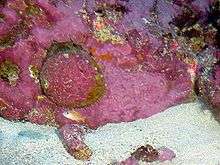 The white abalone, Haliotis sorenseni
The white abalone, Haliotis sorenseni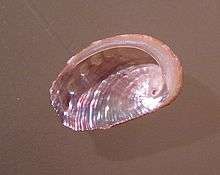 A shell of Haliotis varia form dohrniana
A shell of Haliotis varia form dohrniana
Synonyms
See also
Citations
- Geiger & Groves 1999, p. 872
- Linnaeus 1758, p. 779
- Linnaeus 1767, p. 1255
- Gofas, Tran & Bouchet 2014
- Beesley, Ross & Wells 1998
- Dauphin et al. 1989, p. 9
- Cox 1962, p. 8
- Geiger & Owen 2012
- Hoiberg 1993, p. 7
- Tryon, Jr. 1880, p. 41
- Tryon, Jr. 1880, p. 46
- Anon 2014g
- Leatherman, Stephen (2012). National Geographic Field Guide to the Water's Edge. National Geographic Field Guides. National Geographic. p. 93. ISBN 978-1426208683.
- Lin & Meyers 2005, p. 27 & 38
- "Hypersensitivity Pneumonitis". www.clevelandclinicmeded.com. Retrieved 17 January 2018.
- Simon 2011, p. 39
- Loosanoff 1997, p. 6
- Henshilwood; et al. (October 2011). "A 100,000-Year-Old Ochre-Processing Workshop at Blombos Cave, South Africa". Science. 334 (6053): 219–222. Bibcode:2011Sci...334..219H. doi:10.1126/science.1211535. PMID 21998386.
- Braje, Erlandson & Rick (2007). "An Historic Chinese Abalone Fishery on California's Northern Channel Islands". Historical Archaeology. 41 (4): 117–128. doi:10.1007/BF03377298.
- Anon 2012
- Taggart 2002
- Westaway & Norriss 1997, p. 1
- Simons 2010
- "El marisco más exclusivo del mundo se cría en Galicia". El Pais. PRISA. 28 July 2016. Retrieved 28 July 2016.
- Freeman 2001, p. 1
- "Information Memorandum, 2013 Ranching of Greenlip Abalone, Flinders Bay – Western Australia" (PDF). Ocean Grown Abalone. Ocean Grown Abalone. Archived from the original (PDF) on 10 October 2016. Retrieved 23 April 2016.
- Fitzgerald, Bridget (28 August 2014). "First wild abalone farm in Australia built on artificial reef". Australian Broadcasting Corporation Rural. Australian Broadcasting Corporation. Retrieved 23 April 2016.
It's the same as the wild core product except we've got the aquaculture advantage which is consistency of supply.
- Murphy, Sean (23 April 2016). "Abalone grown in world-first sea ranch in WA 'as good as wild catch'". Australian Broadcasting Corporation News. Australian Broadcasting Corporation. Retrieved 23 April 2016.
So to drive future growth I really believe sea ranching is a great opportunity going forward for some of these coastal communities.
- Jones 2008, p. 65
- Jones 2008, p. 66
- Dubin, Margaret (2008). Tolley, Sara-Larus (ed.). Seaweed, Salmon, and Manzanita Cider: A California Indian Feast. Heyday Books.
- Jones 2008, p. 70
- Akimichi 1999
- Gayot 2010
- Anon 2014
- Anon 2014a
- "FRDC blacklip abalone". Archived from the original on 9 September 2016. Retrieved 5 December 2016.
- "FRDC greenlip abalone". Archived from the original on 4 September 2016. Retrieved 5 December 2016.
- State of California 2008, §29.16(a)
- State of California 2014, §29.15(e)
- State of California 2014, §29.15(a)
- State of California 2014, §29.15(c)
- State of California 2014, §29.15(d)
- Duggan, Tara (13 December 2018). "California abalone season sunk until 2021 to give stressed population time to rebuild". San Francisco Chronicle. San Francisco, California. Retrieved 26 March 2018.
- Smookler 2005, p. 76
- Plagányi, Éva; Butterworth, Doug; Burgener, Markus (1 January 2011). "Illegal and unreported fishing on abalone—Quantifying the extent using a fully integrated assessment model". Fisheries Research. 107 (1–3): 221–232. doi:10.1016/j.fishres.2010.11.005.
- Anon 2007
- "Archived copy". Archived from the original on 18 June 2015. Retrieved 18 June 2015.CS1 maint: archived copy as title (link)
- Anon 2014b
- Anon 1969, p. 16
- "A Guitar Lover's Guide to the CITES Conservation Treaty | Fretboard Journal". Fretboard Journal. 2 September 2008. Retrieved 27 October 2018.
- Field, Les (2008). Abalone Tales. Duke University Press.
- Byrne et al. 2011
- "Ocean Acidification". Smithsonian Ocean. Retrieved 31 May 2019.
- Rogers-Bennett, Laura; et al. (1 October 2002). "Using Spatially Explicit Data to Evaluate Marine Protected Areas for Abalone in Southern California". Conservation Biology. 16 (5): 1308–1317. doi:10.1046/j.1523-1739.2002.01002.x. ISSN 0888-8892.
- "Abalone: History and Future". www.marinebio.net. Retrieved 6 May 2016.
- Abbott & Dance 2000
References
- Abbott, R. Tucker; Dance, S. Peter (2000). Compendium of Seashells (4th ed.). Odyssey Publishing. pp. 19–23. ISBN 978-0-9661720-0-3.CS1 maint: ref=harv (link)
- Akimichi, Tomoya (1999). "The Enduring Appeal of Abalone". Kikkoman Food Forum. Kikkoman.com. Archived from the original on 18 August 2014. Retrieved 16 August 2014.CS1 maint: ref=harv (link)
- Anon (2014). "Abalone Viral Ganglioneuritis". Department of Primary Industries, Parks, Water and Environment. Tasmanian Government. Archived from the original on 23 August 2014. Retrieved 16 August 2014.CS1 maint: ref=harv (link)
- Anon (2014a). "Abalone Fishing". Department of Primary Industries, Parks, Water and Environment. Tasmanian Government. Archived from the original on 26 July 2014. Retrieved 16 August 2014.CS1 maint: ref=harv (link)
- Anon (2014b). "Ormering Tides 2014". visitguernsey.com. State of Guernsey Commerce and Employment. Archived from the original on 19 August 2014. Retrieved 16 August 2014.CS1 maint: ref=harv (link)
- Anon (2014c). "Haliotis kamtschatkana - Jonas, 1845". NatureServe Explorer. Archived from the original on 26 August 2014. Retrieved 22 August 2014.CS1 maint: ref=harv (link)
- Anon (2014d). "Haliotis refescens - Swainson, 1822". NatureServe Explorer. Archived from the original on 26 August 2014. Retrieved 22 August 2014.CS1 maint: ref=harv (link)
- Anon (2014e). "Haliotis sorenseni - Bartsch, 1940". NatureServe Explorer. Archived from the original on 26 August 2014. Retrieved 22 August 2014.CS1 maint: ref=harv (link)
- Anon (2014f). "Haliotis cracherodii - Leach, 1814". NatureServe Explorer. Archived from the original on 26 August 2014. Retrieved 22 August 2014.CS1 maint: ref=harv (link)
- Anon (2014g). "Distribution Map: Haliotis". Ocean Biogeographic Information System. Retrieved 22 August 2014.CS1 maint: ref=harv (link)
- Anon (2012). "Abalone Information: Introduction". Fishtech. Retrieved 16 August 2014.CS1 maint: ref=harv (link)
- Anon (11 April 2007). "Six Arrested in Massive Abalone Bust". Mail & Guardian. Archived from the original on 19 August 2014. Retrieved 16 August 2014.CS1 maint: ref=harv (link)
- Anon (14 January 2009). "Endangered and Threatened Species; Endangered Status for Black Abalone". Federal Register: The Daily Journal of the United States. Archived from the original on 26 August 2014. Retrieved 22 August 2014.CS1 maint: ref=harv (link)
- Anon (2004). "Submission on Consultation Document on Fisheries Research Services Proposed for 2004/2005 and 2004/08 Statement of Intent Including Output Plan for 2004/5" (PDF). New Zealand Ministry for Primary Industries. Archived (PDF) from the original on 4 March 2016. Retrieved 16 August 2014.CS1 maint: ref=harv (link)
- Anon (29 May 2001). "Endangered and Threatened Species; Endangered Status for White Abalone". Federal Register: The Daily Journal of the United States. Archived from the original on 29 July 2014. Retrieved 22 August 2014.CS1 maint: ref=harv (link)
- Anon (15 January 1969). "Illegal Ormering Brings First Underwater Arrest". Park City Daily News. Bowling Green, KY.CS1 maint: ref=harv (link)
- Beesley, P. L.; Ross, G. J. B.; Wells, A. (1998). Mollusca: The Southern Synthesis: An Essential Reference. Melbourne, Australia: CSIRO Publishing. pp. 667–669. ISBN 978-0-643-05756-2.CS1 maint: ref=harv (link)
- Byrne, Maria; Ho, Melanie; Wong, Eunice; Soars, Natalie A.; Selvakumaraswamy, Paulina; Shepard-Brennand, Hannah; Sworjanyn, Symon A.; Davis, Andrew R. (7 August 2011). "Unshelled Abalone and Corrupted Urchins; Development of Marine Calcifiers in a Changing Ocean" (PDF). Proceedings of the Royal Society B: Biological Sciences. 278: 1–9. doi:10.1098/rspb.2010.2404. ISSN 0962-8452. Retrieved 16 August 2014.CS1 maint: ref=harv (link)
- Cox, Keith W. (1962). "California abalone, family Haliotidae". The Resources Agency of California Department of Fish and Game: Fish Bulletin. 118. ISSN 6306-2593.CS1 maint: ref=harv (link)
- Dauphin, Y.; Cuif, J. P.; Mutvei, H.; Denis, A. (1989). "Mineralogy, Chemistry and Ultrastructure of the External Shell-layer in Ten Species of Haliotis With Reference to Haliotis tuberculata (Mollusca, Archaeogastropoda)". Bulletin of the Geological Institutions of the University of Uppsala. 15: 7–38. ISSN 0302-2749.CS1 maint: ref=harv (link)
- EoL (2014). "Haliotis speciosa: Splendid Abalone". Encyclopedia of Life. Archived from the original on 21 August 2014. Retrieved 21 August 2014.CS1 maint: ref=harv (link)
- Freeman, Kylie A. (June 2001). Aquaculture and Related Biological Attributes of Abalone Species in Australia - A Review (PDF). Fisheries Research Report. 128. North Beach, WA, Australia: Department of Fisheries. ISBN 978-0-7309-8456-6. ISSN 1035-4549. Archived from the original (PDF) on 19 August 2014.CS1 maint: ref=harv (link)
- Gayot, Alain (2010). "Maritime Morsels: Fresh Abalone in California". Gayot: The Guide to the Good Life. The Food Paper. Archived from the original on 19 August 2014. Retrieved 16 August 2014.CS1 maint: ref=harv (link)
- Geiger, Daniel L.; Groves, Lindsey T. (September 1999). "Review of Fossil Abalone (Gastropoda, Vetigastropoda, Haliotidae) with Comparison to Recent Species". Journal of Paleontology. 73 (5): 872–885. doi:10.1017/S0022336000040713. ISSN 0022-3360.CS1 maint: ref=harv (link)
- Geiger, Daniel L.; Owen, Buzz (2012). Abalone: Worldwide Haliotidae. Hackenheim, Germany: Conchbooks. ISBN 978-3-9397-6743-5.CS1 maint: ref=harv (link)
- Gofas, Serge; Tran, Bastien; Bouchet, Phillippe (2014). "WoRms Taxon Details: Haliotis Linnaeus, 1758". WoRMS (World Register of Marine Species). Archived from the original on 10 October 2014. Retrieved 16 August 2014.CS1 maint: ref=harv (link)
- Gustafson, Rick; Rumsey, Scott (1 November 2007). "Species of Concern: Pinto Abalone Haliotis Kamtschatkana" (PDF). NOAA: National Marine Fisheries Service. Archived (PDF) from the original on 7 October 2012. Retrieved 22 August 2014.CS1 maint: ref=harv (link)
- Hoiberg, Dale H., ed. (1993). Encyclopædia Britannica. 1: A-ak Bayes (15th ed.). Chicago, IL: Encyclopædia Britannica, Inc. ISBN 978-0-85229-961-6. LCCN 2002113989. Missing or empty
|title=(help) - Jones, Glenn A. (2008). ""Quite the Choicest Protein Dish": The Costs of Consuming Seafood in American Restaurants, 1850-2006". In Starkey, David J.; Holm, Poul; Barnard, Michaela (eds.). Oceans Past: Management Insights from the History of Marine Animal Populations. London, UK: Earthscan. ISBN 978-1-84407-527-0.CS1 maint: ref=harv (link)
- Lin, Albert; Meyers, Marc André (15 January 2005). "Growth and Structure in Abalone Shell". Materials Science and Engineering: A. 390 (1–2): 27–41. doi:10.1016/j.msea.2004.06.072. ISSN 0921-5093.CS1 maint: ref=harv (link)
- Linnaeus, Carl (1758). Systema Naturæ per Regna Tria Naturæ, Secundum Classes, Ordines, Genera, Species, cum Characteribus, Differentiis, Synonymis, Locis [The System of Nature Through the Three Kingdoms of Nature, According to Classes, Orders, Genera, Species, With the Characteristics, Differences, Synonyms, and Locations] (in Latin). 1 (Decima [10th] ed.). Holmia [Stockholm], Sweden: Laurentii Salvii.CS1 maint: ref=harv (link)
- Linnaeus, Carl (1767). Systema Naturæ [The System of Nature] (in Latin). 1, Part 2 (Duodecima [12th] ed.). Holmia [Stockholm], Sweden: Laurentii Salvii.CS1 maint: ref=harv (link)
- Loosanoff, Victor L. (1997). "Abalone". In Johnston, Bernard (ed.). Collier's Encyclopedia. I: A to Ameland (1st ed.). New York, NY: P. F. Collier.CS1 maint: ref=harv (link)
- McDougall, P. T.; Ploss, J.; Tuthill, J. (2006). "Haliotis kamtschatkana". IUCN RedList. Archived from the original on 26 August 2014. Retrieved 22 August 2014.CS1 maint: ref=harv (link)
- Neuman, Melissa (10 June 2009). "Species of Concern: Green Abalone Haliotis fulgens" (PDF). NOAA: National Marine Fisheries Service. Archived (PDF) from the original on 4 March 2016. Retrieved 22 August 2014.CS1 maint: ref=harv (link)
- Neuman, Melissa (2 November 2007). "Species of Concern: Pink Abalone Haliotis corrugata" (PDF). NOAA: National Marine Fisheries Service. Archived (PDF) from the original on 4 March 2016. Retrieved 22 August 2014.CS1 maint: ref=harv (link)
- Simon, Carol A. (2011). "Polydora and Dipolydora (Polychaeta: Spionidae) Associated With Molluscs on the South Coast of South Africa, With Descriptions of Two New Species". African Invertebrates. 52 (1): 39–50. doi:10.5733/afin.052.0104. ISSN 1681-5556.CS1 maint: ref=harv (link)
- Simons, Stefan (14 April 2010). "Abalone-Zucht in der Bretagne: Sylvains Meerestrüffel" [Abalone Farming in Brittany: Sylvain Sea Truffles]. Spiegel Online (in German). Archived from the original on 4 February 2014. Retrieved 16 August 2014.CS1 maint: ref=harv (link)
- Smith, G.; Stamm, C.; Petrovic, F. (2003). "Haliotis cracherodii". IUCN RedList. Archived from the original on 7 July 2014. Retrieved 22 August 2014.CS1 maint: ref=harv (link)
- Smookler, Michael (2005). San Mateo County Coast. Arcadia Publishing. ISBN 978-0-7385-3061-1.CS1 maint: ref=harv (link)
- State of California (2014). "Title 14, Division 1, Subdivision 1, Chapter 4, Article 1, §29.15 Abalone". Westlaw. Archived from the original on 4 March 2016. Retrieved 16 August 2014.CS1 maint: ref=harv (link)
- State of California (January 2011). "Special Animals (898 Taxa)" (PDF). State of California: Division of Fish and Game. Archived from the original (PDF) on 24 January 2014. Retrieved 22 August 2014.CS1 maint: ref=harv (link)
- State of California (2008). "Title 14, Division 1, Subdivision 1, Chapter 4, Article 1, §29.16 Abalone Report Card and Tagging Requirements (FG 2915, See Section 701)". Westlaw. Archived from the original on 25 December 2016. Retrieved 16 August 2014.CS1 maint: ref=harv (link)
- Taggart, Stewart (25 January 2002). "Abalone Farming on a Boat". Wired. Archived from the original on 16 August 2014. Retrieved 16 August 2014.CS1 maint: ref=harv (link)
- Tran, Bastien; Bouchet, Phillippe (2009). "WoRMS Taxon Details: Haliotis corrugata oweni Talmadge, 1966". WoRMS: World Register of Marine Species. Archived from the original on 17 October 2014. Retrieved 19 August 2014.CS1 maint: ref=harv (link)
- Tryon, Jr., George W. (1880). Manual of Conchology; Structural and Systematic With Illustrations of the Species (PDF). II: Muricinæ, Purpurinæ. Philadelphia, PA: Academy of Natural Sciences.CS1 maint: ref=harv (link)
- Westaway, Cameron; Norriss, Jeff (October 1997). "Abalone Aquaculture in Western Australia" (PDF). Fisheries Management Paper. 109. ISSN 0819-4327. Archived from the original (PDF) on 19 August 2014.CS1 maint: ref=harv (link)
Further reading
- Field, Les (2008). Lomawaima, K. Tsianina (ed.). Abalone Tales: Collaborative Explorations of Sovereignty and Identity in Native California. Durham, NC: Duke University Press. ISBN 978-0-8223-4233-5.
- Geiger, Daniel L.; Poppe, G. T. (2000). A Conchological Iconography: The family Haliotidae. Hackenheim Germany: Conchbooks.CS1 maint: ref=harv (link)
- Pollard, Graham (2001). "Abalone Fishing in South Australia" (PDF). South Pacific Underwater Medicine Society Journal. 31 (3). Archived from the original (PDF) on 19 August 2014. Retrieved 16 August 2014.CS1 maint: ref=harv (link)
External links
| Wikispecies has information related to Haliotis |
| Wikimedia Commons has media related to Abalones. |
- . Encyclopædia Britannica (11th ed.). 1911.
- Abalone: Species Diversity
- ABMAP: The Abalone Mapping Project
- Abalone biology
- Conchology
- Hardy's Internet Guide to Marine Gastropods : Shell Catalog
- book on crafting with Abalone Shell
- Fisheries Western Australia - Abalone Fact Sheet
- Imagemap of worldwide abalone distribution
- Oman’s Abalone Harvest
- Pro abalone diver, Mallacoota, Victoria (1967)
- Tathra NSW(1961), Abalone (1963)
- Fathom magazine "The Abalone Divers" Pages 43,44,45 (1972)
- Abalone Healing Properties
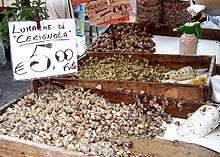
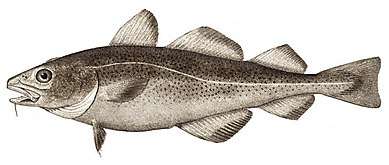
.png)
